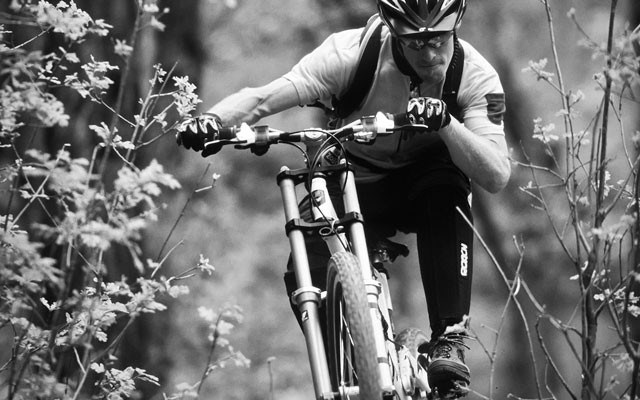It isn't every day that the anniversary of an outdoor magazine offers testament to anything more than the passing of time, and, increasingly in the case of magazines, mere survival. But with the 20-year milestone being celebrated all this year by BIKE comes a crap-ton more: the entire modern ethos and evolution of mountain biking, and, just as importantly, the way it's documented.
Before BIKE, you see, there was no such thing as a "mountain bike photographer," and magazines dedicated to the sport were by-and-large race-oriented, their covers universally cluttered with what was then considered the acme of "MB" photojournalism: fill-flash shots of sweaty, wild-eyed, lycra-and-logo-clad racers. Variations on the theme included a rider being splattered with water or mud, wearing warm- or cool-weather clothing, sometimes a headlamp. The sport's Marin Country grassroots heroes had been left in the California dust in a rush for sport credibility and the mags were filled with downhill and cross-country race results, racer profiles, bike tests and gear, gear, gear. All the movies advertised in these mags plumbed some form of competition, ignoring culture, innovation, and travel. Adventure was nowhere to be found. The idea of freeriding had yet to coalesce. Bike parks were light-years away. Worst of all, everyone was still wearing lycra.
But that all changed when the first issue of BIKE hit newsstands in March 1994. Conceived and launched under the Surfer Publications banner by the good folks at POWDER magazine — publisher Brent Diamond along with editors Steve Casimiro and Rob Story — BIKE hit the dirt spinning. While mountain biking isn't skiing and never will be, these folks were smart enough to see the crossovers between two deeply experiential pastimes that could take you places that you'd never been — both literally and figuratively — and perhaps wouldn't otherwise go. In mountain biking, this applied equally to the idea of a trail deep into wilderness or the heart of an urban greenspace, whether riding near home or in an exotic landscape. As a contributing editor at POWDER I was invited to write an essay for the first issue, a task I welcomed, as it was a chance to enter uncharted territory — a tabula rasa on which we could impose our vision of a genre-to-be. Indeed "The Wreath" wasn't much about mountain biking per se, but the feelings evoked by a faded memorial to suicide victims underneath the Bloor Viaduct in Toronto's Don Valley, something I wouldn't have seen had I not been able to bike the dusty trail that passed it, and which had made me think deeply — something I would find myself doing a lot of on a bike. Encouragement to experiment was everywhere, and thanks to an art director who took that to heart my feature in the second issue — "Have you Driven a Fjord Lately?" about a mountain-bike traverse of Iceland — had a feel of the uncertainty of adventure, a brand new way to approach the sport. The starting gun had been fired, the wheels were turning, and BIKE never looked back.
To fulfill the mission, and because it was part of the photo-driven SURFER stable, the most immediate need was innovative photography that transmitted the experiences evoked by mountain biking. There wasn't much out there, so recently minted POWDER photo editor David Reddick set about finding it, encouraging its creation over the phone almost daily, and curating the results—a task he continues, now iconically, to this day. The mountain-bike photo vacuum was one into which many an outdoor photographer looking for a new challenge happily leaped (many directly off the POWDER masthead), and the evolution of the trope was fast and furious. By 1996, BIKE's third year of publication, the mag had grown from five to 10 issues a year, people were travelling the globe to put knobby tires to dirt, and mountain-bike photography had become a genuine genre.
In addition to the travel revolution, much else was going on. Mountain bike festivals were booming, personalities and attitudes and looks were emerging, and bikes, components, materials, and clothing were all evolving to meet the new demands of what would soon become "freeriding," a term its proponents in the hinterlands of B.C. were already using, and which I had the privilege of birthing to the literature in the feature "Sick," based on a trip to Kamloops with a young Richie Schley, Brett Tippie, Squamish-based cinematographer Christian Begin and Whistler photo icon Eric Berger. Meanwhile, downhilling and cross-country and trials and even off-trail riding were coming together. Vancouver's wild and globally influential North Shore trail-building scene was taking root; and everywhere hard-charging folks were seeing what their bikes could do off of trails on real mountain terrain. A genuine global mountain bike culture was finding an identity outside of racing, and BIKE, which at first had merely held up a mirror, was now driving the bus.
Many factors were involved in the establishment and evolution of today's unbelievably vibrant mountain bike scene, from technical to economic, from athletes to the companies they represented, from the photographers and movie-makers who jumped on board to expand that universe. Although there may have been a whiff of the same air of inevitability one could sense in the early snowboard milieu, it's fair to say that without BIKE's pioneering exposure of the greater mountain-biking world and its crucible of photo creativity, we may or may not have ever seen the likes of bike parks, Crankworx, and Deep Summer, or the wicked interpretive talents of a host of photographers too numerous to name brought to bear on the sport. So cheers to 20 years of BIKE, for which we should be grateful — if only for not having to still wear lycra.
Leslie Anthony is a Whistler-based author, editor, biologist and bon vivant who has never met a mountain he didn't like.




